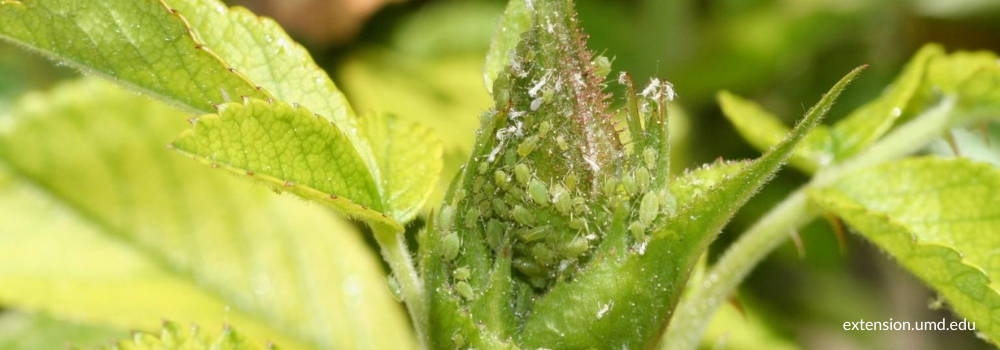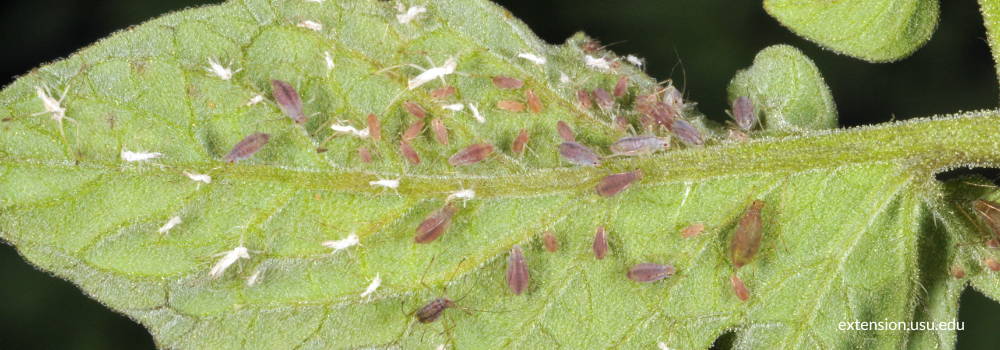Aphids on Plants: Their Damage and How to Eliminate Them
Aphids are small sucking insects that belong to the Aphididae insect family. There are almost 5,000 species of aphids and several hundred of them are extremely destructive. Adult aphids have a pear-shaped body that is less than 1/8" long.
The most common species of aphids is the pear aphid, which is light green, but you can also find white aphids on plants and black aphids on plants. Some aphids are grey or pink. Aphids can develop wings when the colony becomes too crowded and fly to another fruit tree or plant to start another colony.
What Aphid Damage Looks Like
Adults and nymphs eat plant juices, leaving behind misshapen, yellowing, curling or stunted leaves. Most aphids prefer new growth, but some species like green peach aphids feed on various plants. You will also see aphids on roses. Other species like the rosy apple aphids feed on only one or a few plant varieties.
Aphids are usually found on the undersides of leaves. If you found a sticky substance on the stems or leaves, it is a sign that your plants are infested with aphids. This substance is called honeydew. Aphids secrete honeydew when they feed on plants and this substance can attract ants and other insects that gather the liquid for food.
The honeydew can drop onto your driveway, car or outdoor furniture and encourage sooty mould growth, a fungal disease that causes leaves and branches to turn black. Galls may also form on leaves or roots due to the feeding habits of aphids.
How to Get Rid of Aphids on Plants
The best way to control aphids is by employing defensive methods. Healthy plants are less prone to aphid damage compared to stressed, weak and under potted plants. Vigorous plants are less likely to draw in garden pests in the first place. But if you are dealing with an aphid infestation now, you can use the following methods to get rid of them:
Water
Spray infested plants with a strong stream of water from a hose. You can also use a cotton swab to knock them off your plants. This method works best for light aphid infestations. You can also dip the plants in room-temperature water. This method is ideal for plants with delicate foliage. You can also remove heavily infested parts and throw them outside.
DIY insect spray
You can make a DIY insect spray by mixing cayenne pepper (one teaspoon), one garlic bulb and one small onion in a blender or food processor. Add the paste to one quart of water then steep for one hour. Strain the mixture with cheesecloth then adds one tablespoon of dish soap. You can store the mixture in the fridge for a week.
Neem oil
Neem oil has fungicidal and insecticidal properties that can kill aphids. According to the EPA, neem oil is safe to use on food plants, ornamentals, and vegetables.
Insecticidal soaps
You can buy insecticidal soaps or make your own. If you want to make one, you only need to mix one teaspoon of dish detergent with one gallon of water. Transfer the mixture into a spray bottle and use it on infested plants. If you want to buy one, choose a product that has no additives or perfumes that can damage plants.
For insecticidal soaps, we recommend the use of Safers Insecticidal Soap RTU 1L, Safers 3-In-1 Spray RTU 1L, and Safers Defender 1L RTU.
Chemical spray
Chemical sprays should be used as a last resort or when the infestation is too severe that you have no other choice, but to use such products. Treat the infested plant with chemical sprays that contain pyrethroids, pyrethrins or imidacloprid. Pyrethrin-based chemical sprays have low toxicity, so they are the safest product to use.
For chemical sprays, you can use Ortho Bug B Gon Eco Insecticidal Soap RTU 1L or the Safers End-All II 1 L RTU C7.
Diatomaceous Earth
Diatomaceous earth (DE) can kill aphids, but it will not harm plants. However, it is harmful to butterfly larvae and bees, so consider covering your plants with netting to prevent these beneficial insects from feeding on treated plants. A product we recommend is:
Natural Predators
Aphids have natural predators such as the soldier beetles, lady beetles, brown and green lacewings, blister beetles, hoverflies, damsel bugs and big-eyed bugs. Both nymphs and adults usually eat aphids. Parasitic wasps or parasitoids that eat aphids include braconid wasps and ichneumon.
How Do Aphids Get on Plants?
How do you get aphids on plants? Aphid populations tend to grow fast. They are also highly mobile as winged aphids can quickly travel from plant to plant and start a new colony. In outdoor gardens, aphid colonies are usually protected by ants that feed on the honeydew of aphids. Indoors, aphids travel from plant to plant by crawling or flying.
Aphids can cause significant plant damage by feeding on the sap of new plant growth. They usually feed in groups and attack the soft stems to extract plant juices. Due to their feeding habits, the new growth may look stunted or crinkled. If the aphid infestation is severe, the plant will start to drop leaves. That is why you should implement the methods stated above as soon as you see aphids on indoor plants.



